Management and Organization: Challenging Assumptions Essay
VerifiedAdded on 2023/04/11
|14
|3214
|419
Essay
AI Summary
This essay delves into the realm of management and organization, commencing with a definition of management as the orchestration of resources and employee efforts to achieve organizational objectives. It then introduces classical managerial theory, highlighting its emphasis on hierarchical structures and increased productivity, while also incorporating an argument on its relevancy in the modern era. The essay further explores strategy management, examining its role in aligning actions with organizational missions and visions, but also acknowledges potential drawbacks like rigidity and the prioritization of rules over employee development. The essay then transitions to the 14 principles of management by Henry Fayol, discussing their advantages and disadvantages. Subsequently, it explores Henry Mintzberg's managerial theory, which emphasizes practical training and a manager's ten roles. The essay concludes by advocating for a philosophical perspective on management, emphasizing moral and ethical considerations. The essay challenges assumptions in management theories and explores their impact on management practices.
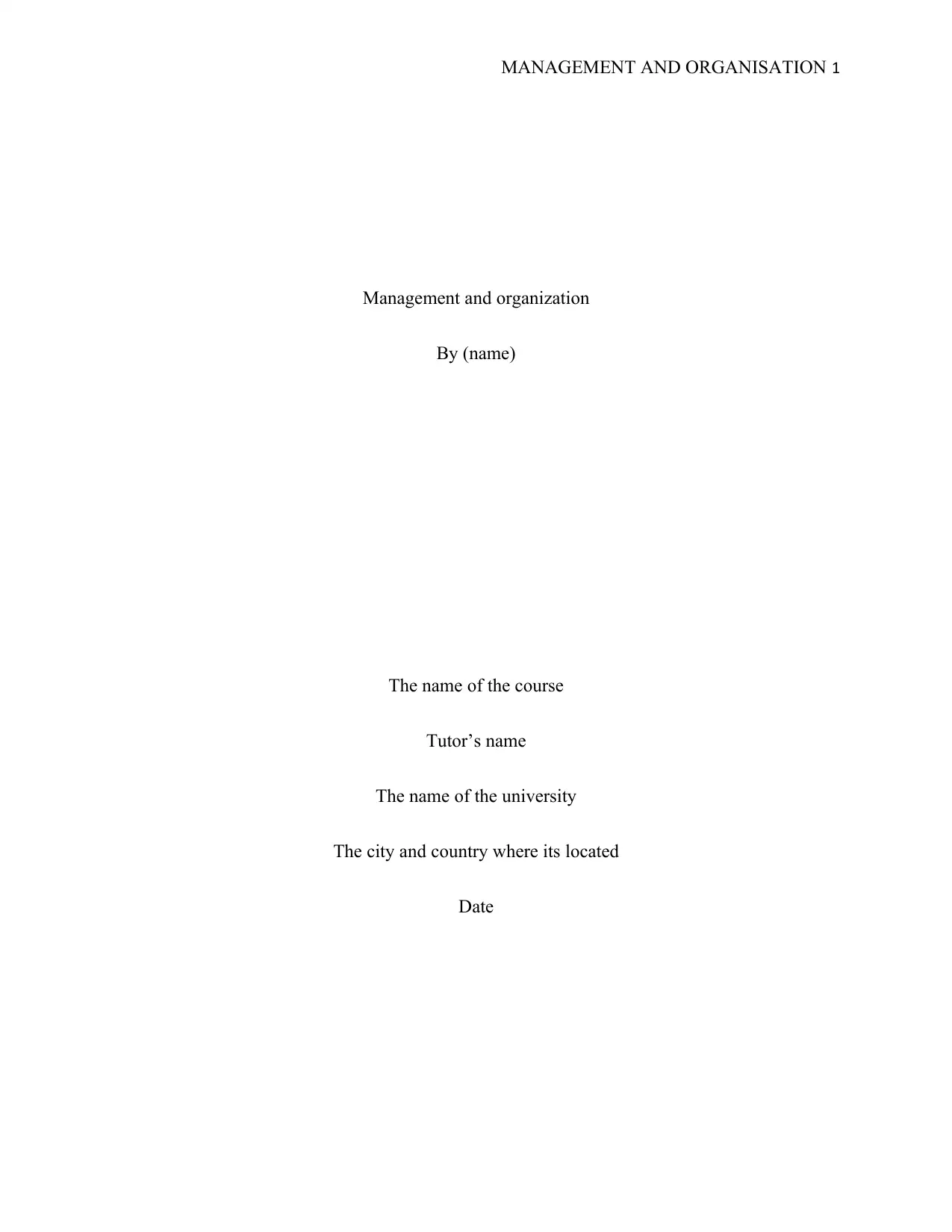
MANAGEMENT AND ORGANISATION 1
Management and organization
By (name)
The name of the course
Tutor’s name
The name of the university
The city and country where its located
Date
Management and organization
By (name)
The name of the course
Tutor’s name
The name of the university
The city and country where its located
Date
Paraphrase This Document
Need a fresh take? Get an instant paraphrase of this document with our AI Paraphraser
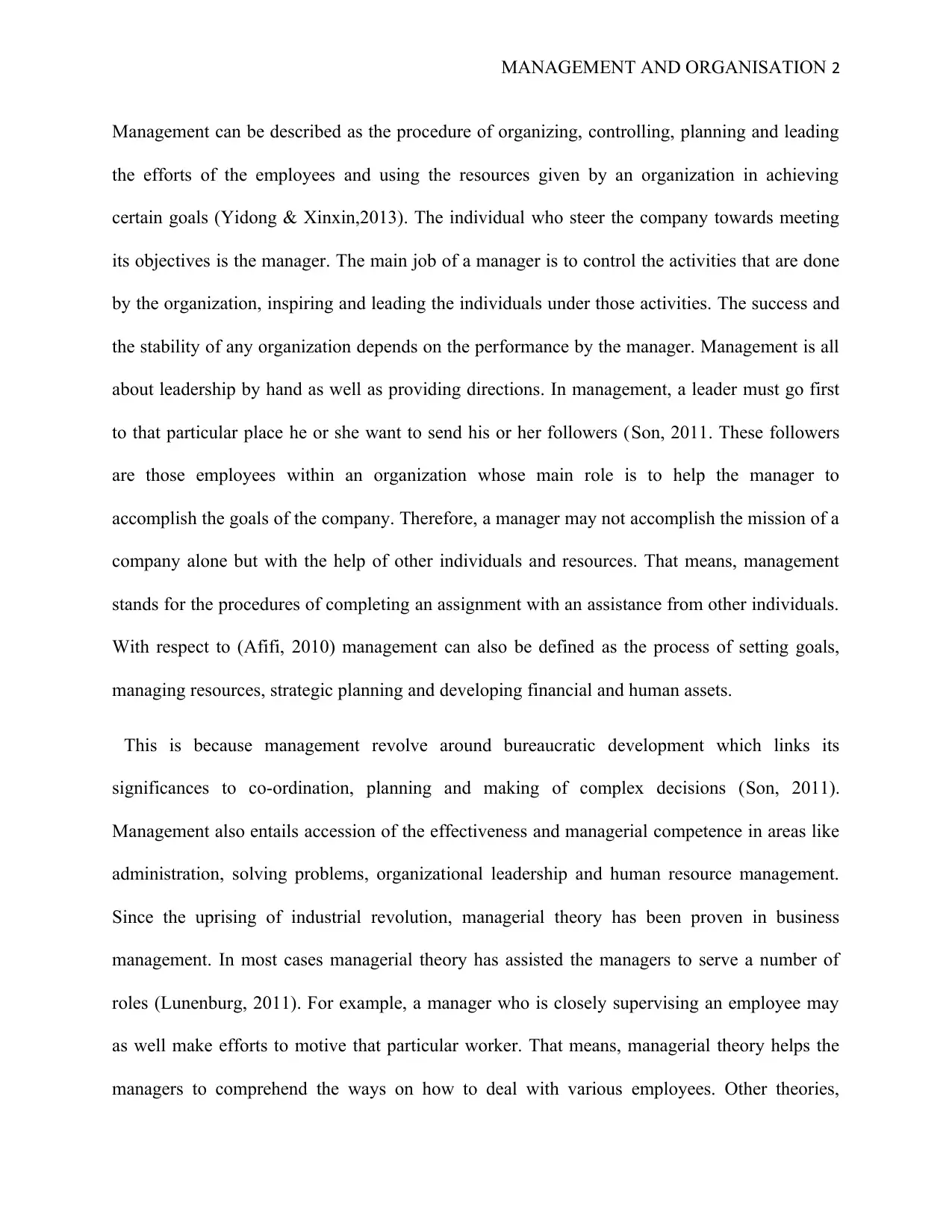
MANAGEMENT AND ORGANISATION 2
Management can be described as the procedure of organizing, controlling, planning and leading
the efforts of the employees and using the resources given by an organization in achieving
certain goals (Yidong & Xinxin,2013). The individual who steer the company towards meeting
its objectives is the manager. The main job of a manager is to control the activities that are done
by the organization, inspiring and leading the individuals under those activities. The success and
the stability of any organization depends on the performance by the manager. Management is all
about leadership by hand as well as providing directions. In management, a leader must go first
to that particular place he or she want to send his or her followers (Son, 2011. These followers
are those employees within an organization whose main role is to help the manager to
accomplish the goals of the company. Therefore, a manager may not accomplish the mission of a
company alone but with the help of other individuals and resources. That means, management
stands for the procedures of completing an assignment with an assistance from other individuals.
With respect to (Afifi, 2010) management can also be defined as the process of setting goals,
managing resources, strategic planning and developing financial and human assets.
This is because management revolve around bureaucratic development which links its
significances to co-ordination, planning and making of complex decisions (Son, 2011).
Management also entails accession of the effectiveness and managerial competence in areas like
administration, solving problems, organizational leadership and human resource management.
Since the uprising of industrial revolution, managerial theory has been proven in business
management. In most cases managerial theory has assisted the managers to serve a number of
roles (Lunenburg, 2011). For example, a manager who is closely supervising an employee may
as well make efforts to motive that particular worker. That means, managerial theory helps the
managers to comprehend the ways on how to deal with various employees. Other theories,
Management can be described as the procedure of organizing, controlling, planning and leading
the efforts of the employees and using the resources given by an organization in achieving
certain goals (Yidong & Xinxin,2013). The individual who steer the company towards meeting
its objectives is the manager. The main job of a manager is to control the activities that are done
by the organization, inspiring and leading the individuals under those activities. The success and
the stability of any organization depends on the performance by the manager. Management is all
about leadership by hand as well as providing directions. In management, a leader must go first
to that particular place he or she want to send his or her followers (Son, 2011. These followers
are those employees within an organization whose main role is to help the manager to
accomplish the goals of the company. Therefore, a manager may not accomplish the mission of a
company alone but with the help of other individuals and resources. That means, management
stands for the procedures of completing an assignment with an assistance from other individuals.
With respect to (Afifi, 2010) management can also be defined as the process of setting goals,
managing resources, strategic planning and developing financial and human assets.
This is because management revolve around bureaucratic development which links its
significances to co-ordination, planning and making of complex decisions (Son, 2011).
Management also entails accession of the effectiveness and managerial competence in areas like
administration, solving problems, organizational leadership and human resource management.
Since the uprising of industrial revolution, managerial theory has been proven in business
management. In most cases managerial theory has assisted the managers to serve a number of
roles (Lunenburg, 2011). For example, a manager who is closely supervising an employee may
as well make efforts to motive that particular worker. That means, managerial theory helps the
managers to comprehend the ways on how to deal with various employees. Other theories,
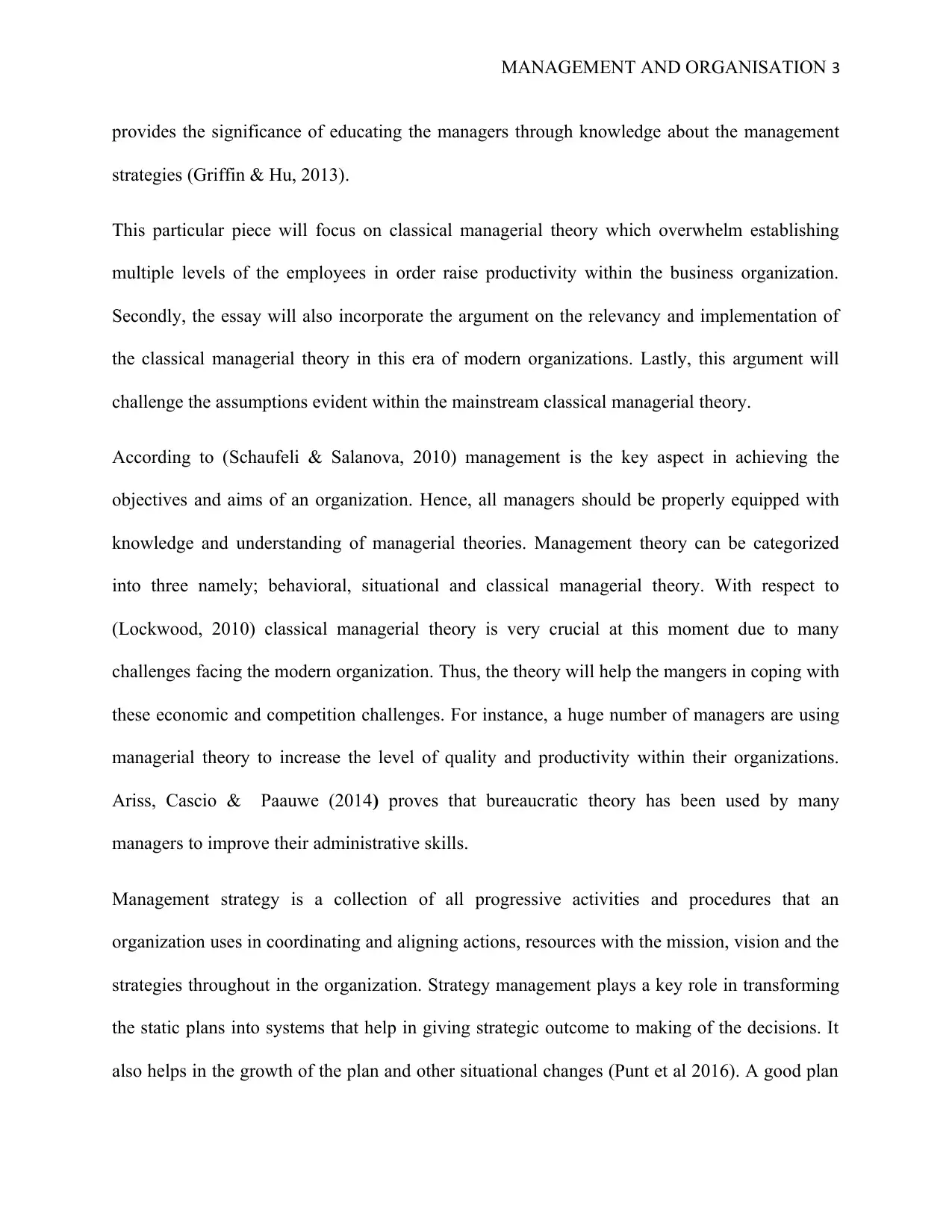
MANAGEMENT AND ORGANISATION 3
provides the significance of educating the managers through knowledge about the management
strategies (Griffin & Hu, 2013).
This particular piece will focus on classical managerial theory which overwhelm establishing
multiple levels of the employees in order raise productivity within the business organization.
Secondly, the essay will also incorporate the argument on the relevancy and implementation of
the classical managerial theory in this era of modern organizations. Lastly, this argument will
challenge the assumptions evident within the mainstream classical managerial theory.
According to (Schaufeli & Salanova, 2010) management is the key aspect in achieving the
objectives and aims of an organization. Hence, all managers should be properly equipped with
knowledge and understanding of managerial theories. Management theory can be categorized
into three namely; behavioral, situational and classical managerial theory. With respect to
(Lockwood, 2010) classical managerial theory is very crucial at this moment due to many
challenges facing the modern organization. Thus, the theory will help the mangers in coping with
these economic and competition challenges. For instance, a huge number of managers are using
managerial theory to increase the level of quality and productivity within their organizations.
Ariss, Cascio & Paauwe (2014) proves that bureaucratic theory has been used by many
managers to improve their administrative skills.
Management strategy is a collection of all progressive activities and procedures that an
organization uses in coordinating and aligning actions, resources with the mission, vision and the
strategies throughout in the organization. Strategy management plays a key role in transforming
the static plans into systems that help in giving strategic outcome to making of the decisions. It
also helps in the growth of the plan and other situational changes (Punt et al 2016). A good plan
provides the significance of educating the managers through knowledge about the management
strategies (Griffin & Hu, 2013).
This particular piece will focus on classical managerial theory which overwhelm establishing
multiple levels of the employees in order raise productivity within the business organization.
Secondly, the essay will also incorporate the argument on the relevancy and implementation of
the classical managerial theory in this era of modern organizations. Lastly, this argument will
challenge the assumptions evident within the mainstream classical managerial theory.
According to (Schaufeli & Salanova, 2010) management is the key aspect in achieving the
objectives and aims of an organization. Hence, all managers should be properly equipped with
knowledge and understanding of managerial theories. Management theory can be categorized
into three namely; behavioral, situational and classical managerial theory. With respect to
(Lockwood, 2010) classical managerial theory is very crucial at this moment due to many
challenges facing the modern organization. Thus, the theory will help the mangers in coping with
these economic and competition challenges. For instance, a huge number of managers are using
managerial theory to increase the level of quality and productivity within their organizations.
Ariss, Cascio & Paauwe (2014) proves that bureaucratic theory has been used by many
managers to improve their administrative skills.
Management strategy is a collection of all progressive activities and procedures that an
organization uses in coordinating and aligning actions, resources with the mission, vision and the
strategies throughout in the organization. Strategy management plays a key role in transforming
the static plans into systems that help in giving strategic outcome to making of the decisions. It
also helps in the growth of the plan and other situational changes (Punt et al 2016). A good plan
⊘ This is a preview!⊘
Do you want full access?
Subscribe today to unlock all pages.

Trusted by 1+ million students worldwide
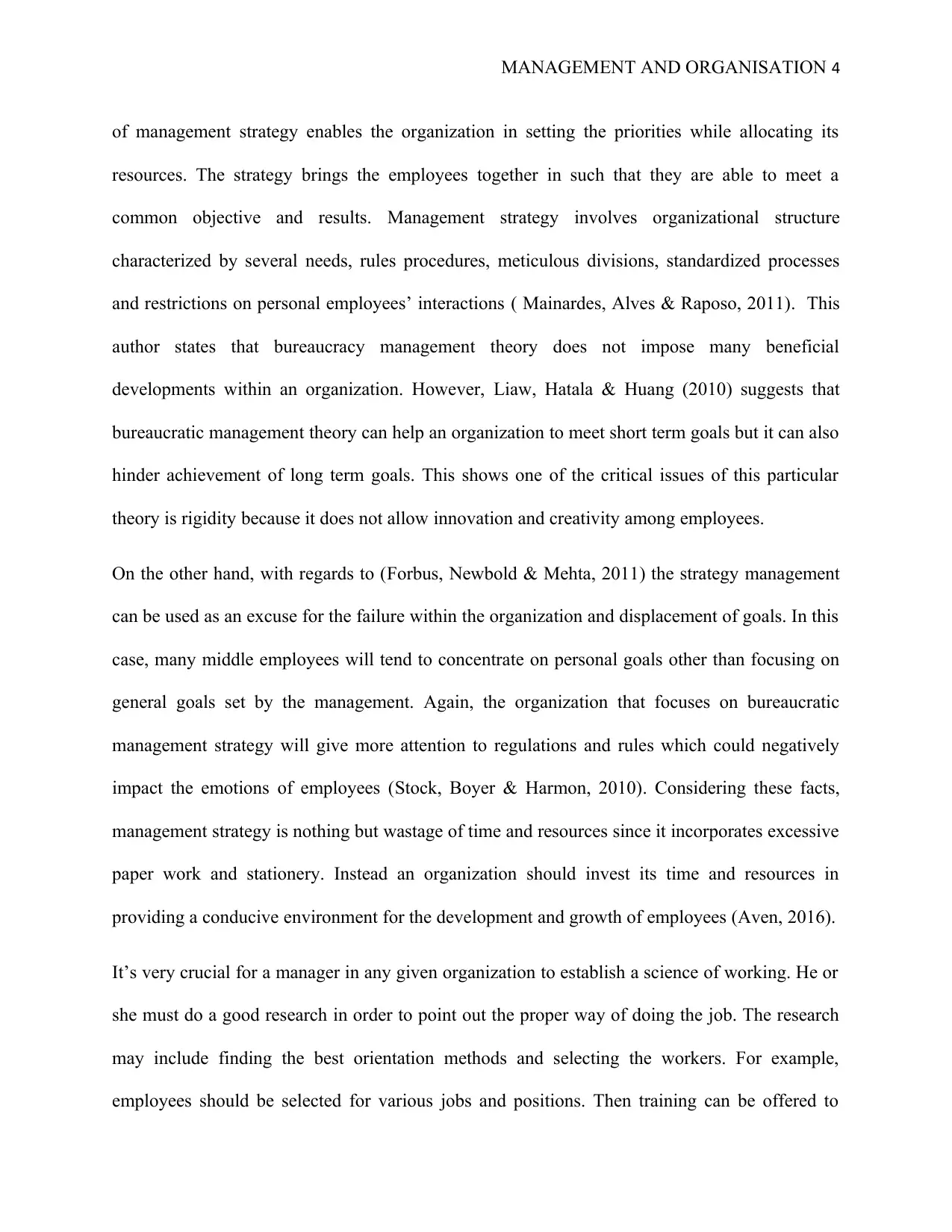
MANAGEMENT AND ORGANISATION 4
of management strategy enables the organization in setting the priorities while allocating its
resources. The strategy brings the employees together in such that they are able to meet a
common objective and results. Management strategy involves organizational structure
characterized by several needs, rules procedures, meticulous divisions, standardized processes
and restrictions on personal employees’ interactions ( Mainardes, Alves & Raposo, 2011). This
author states that bureaucracy management theory does not impose many beneficial
developments within an organization. However, Liaw, Hatala & Huang (2010) suggests that
bureaucratic management theory can help an organization to meet short term goals but it can also
hinder achievement of long term goals. This shows one of the critical issues of this particular
theory is rigidity because it does not allow innovation and creativity among employees.
On the other hand, with regards to (Forbus, Newbold & Mehta, 2011) the strategy management
can be used as an excuse for the failure within the organization and displacement of goals. In this
case, many middle employees will tend to concentrate on personal goals other than focusing on
general goals set by the management. Again, the organization that focuses on bureaucratic
management strategy will give more attention to regulations and rules which could negatively
impact the emotions of employees (Stock, Boyer & Harmon, 2010). Considering these facts,
management strategy is nothing but wastage of time and resources since it incorporates excessive
paper work and stationery. Instead an organization should invest its time and resources in
providing a conducive environment for the development and growth of employees (Aven, 2016).
It’s very crucial for a manager in any given organization to establish a science of working. He or
she must do a good research in order to point out the proper way of doing the job. The research
may include finding the best orientation methods and selecting the workers. For example,
employees should be selected for various jobs and positions. Then training can be offered to
of management strategy enables the organization in setting the priorities while allocating its
resources. The strategy brings the employees together in such that they are able to meet a
common objective and results. Management strategy involves organizational structure
characterized by several needs, rules procedures, meticulous divisions, standardized processes
and restrictions on personal employees’ interactions ( Mainardes, Alves & Raposo, 2011). This
author states that bureaucracy management theory does not impose many beneficial
developments within an organization. However, Liaw, Hatala & Huang (2010) suggests that
bureaucratic management theory can help an organization to meet short term goals but it can also
hinder achievement of long term goals. This shows one of the critical issues of this particular
theory is rigidity because it does not allow innovation and creativity among employees.
On the other hand, with regards to (Forbus, Newbold & Mehta, 2011) the strategy management
can be used as an excuse for the failure within the organization and displacement of goals. In this
case, many middle employees will tend to concentrate on personal goals other than focusing on
general goals set by the management. Again, the organization that focuses on bureaucratic
management strategy will give more attention to regulations and rules which could negatively
impact the emotions of employees (Stock, Boyer & Harmon, 2010). Considering these facts,
management strategy is nothing but wastage of time and resources since it incorporates excessive
paper work and stationery. Instead an organization should invest its time and resources in
providing a conducive environment for the development and growth of employees (Aven, 2016).
It’s very crucial for a manager in any given organization to establish a science of working. He or
she must do a good research in order to point out the proper way of doing the job. The research
may include finding the best orientation methods and selecting the workers. For example,
employees should be selected for various jobs and positions. Then training can be offered to
Paraphrase This Document
Need a fresh take? Get an instant paraphrase of this document with our AI Paraphraser
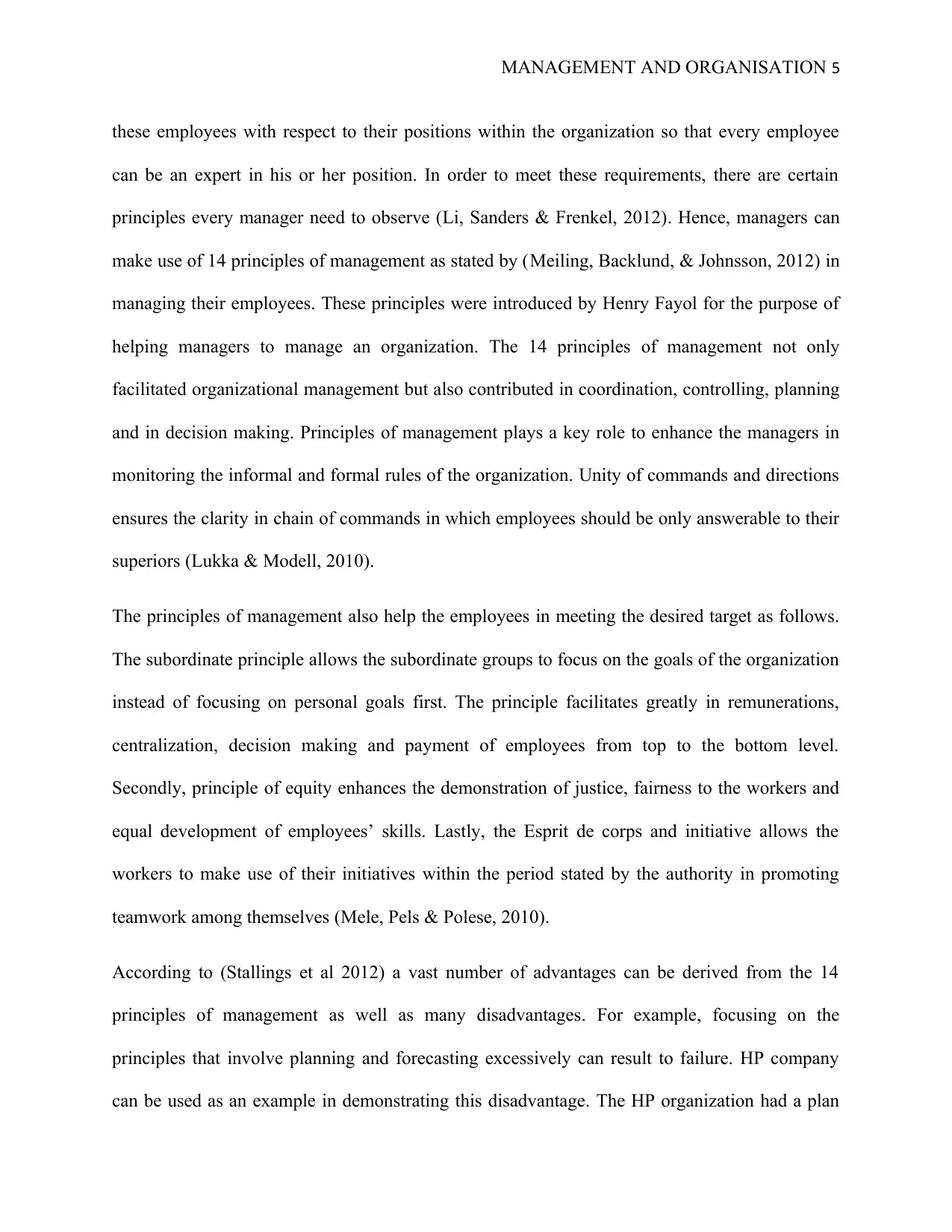
MANAGEMENT AND ORGANISATION 5
these employees with respect to their positions within the organization so that every employee
can be an expert in his or her position. In order to meet these requirements, there are certain
principles every manager need to observe (Li, Sanders & Frenkel, 2012). Hence, managers can
make use of 14 principles of management as stated by (Meiling, Backlund, & Johnsson, 2012) in
managing their employees. These principles were introduced by Henry Fayol for the purpose of
helping managers to manage an organization. The 14 principles of management not only
facilitated organizational management but also contributed in coordination, controlling, planning
and in decision making. Principles of management plays a key role to enhance the managers in
monitoring the informal and formal rules of the organization. Unity of commands and directions
ensures the clarity in chain of commands in which employees should be only answerable to their
superiors (Lukka & Modell, 2010).
The principles of management also help the employees in meeting the desired target as follows.
The subordinate principle allows the subordinate groups to focus on the goals of the organization
instead of focusing on personal goals first. The principle facilitates greatly in remunerations,
centralization, decision making and payment of employees from top to the bottom level.
Secondly, principle of equity enhances the demonstration of justice, fairness to the workers and
equal development of employees’ skills. Lastly, the Esprit de corps and initiative allows the
workers to make use of their initiatives within the period stated by the authority in promoting
teamwork among themselves (Mele, Pels & Polese, 2010).
According to (Stallings et al 2012) a vast number of advantages can be derived from the 14
principles of management as well as many disadvantages. For example, focusing on the
principles that involve planning and forecasting excessively can result to failure. HP company
can be used as an example in demonstrating this disadvantage. The HP organization had a plan
these employees with respect to their positions within the organization so that every employee
can be an expert in his or her position. In order to meet these requirements, there are certain
principles every manager need to observe (Li, Sanders & Frenkel, 2012). Hence, managers can
make use of 14 principles of management as stated by (Meiling, Backlund, & Johnsson, 2012) in
managing their employees. These principles were introduced by Henry Fayol for the purpose of
helping managers to manage an organization. The 14 principles of management not only
facilitated organizational management but also contributed in coordination, controlling, planning
and in decision making. Principles of management plays a key role to enhance the managers in
monitoring the informal and formal rules of the organization. Unity of commands and directions
ensures the clarity in chain of commands in which employees should be only answerable to their
superiors (Lukka & Modell, 2010).
The principles of management also help the employees in meeting the desired target as follows.
The subordinate principle allows the subordinate groups to focus on the goals of the organization
instead of focusing on personal goals first. The principle facilitates greatly in remunerations,
centralization, decision making and payment of employees from top to the bottom level.
Secondly, principle of equity enhances the demonstration of justice, fairness to the workers and
equal development of employees’ skills. Lastly, the Esprit de corps and initiative allows the
workers to make use of their initiatives within the period stated by the authority in promoting
teamwork among themselves (Mele, Pels & Polese, 2010).
According to (Stallings et al 2012) a vast number of advantages can be derived from the 14
principles of management as well as many disadvantages. For example, focusing on the
principles that involve planning and forecasting excessively can result to failure. HP company
can be used as an example in demonstrating this disadvantage. The HP organization had a plan
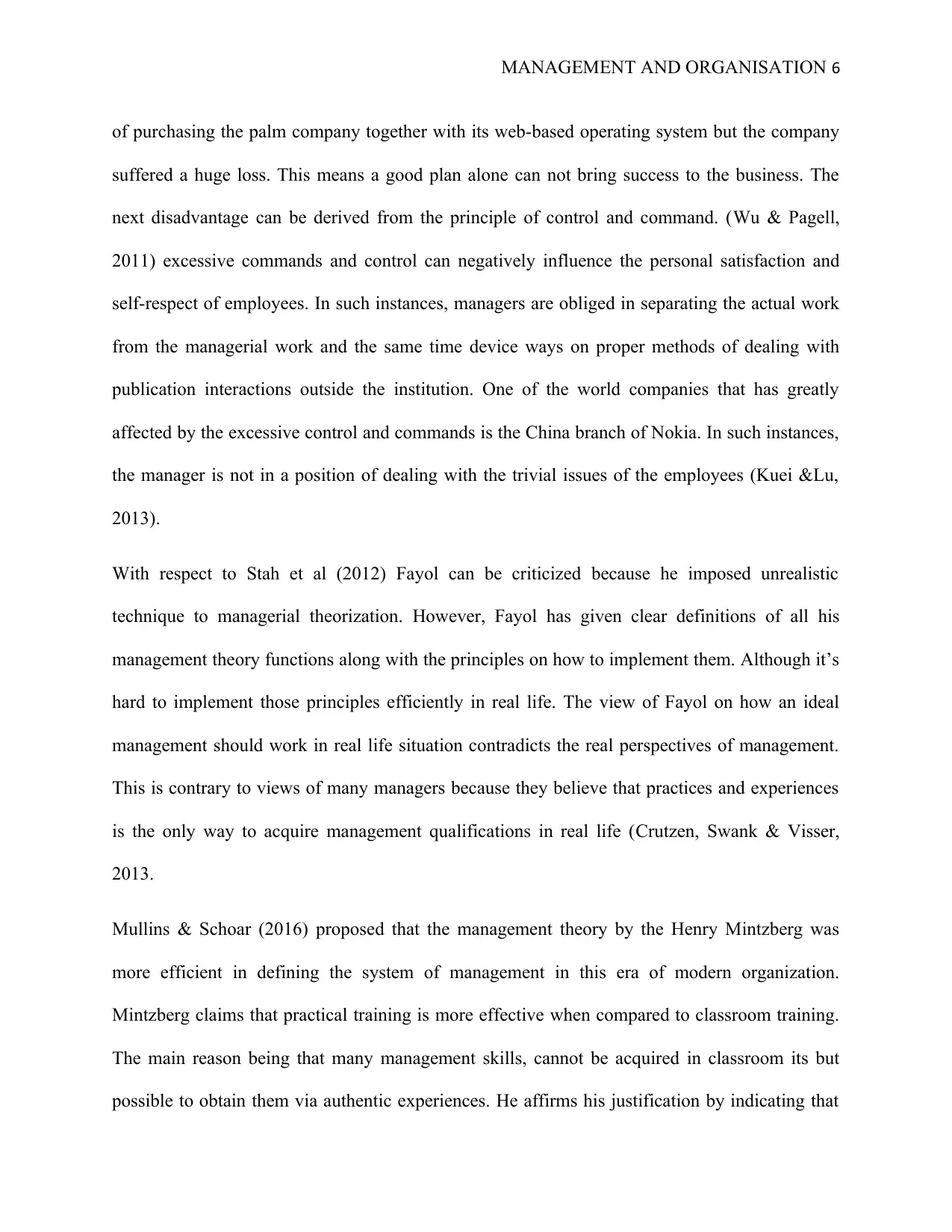
MANAGEMENT AND ORGANISATION 6
of purchasing the palm company together with its web-based operating system but the company
suffered a huge loss. This means a good plan alone can not bring success to the business. The
next disadvantage can be derived from the principle of control and command. (Wu & Pagell,
2011) excessive commands and control can negatively influence the personal satisfaction and
self-respect of employees. In such instances, managers are obliged in separating the actual work
from the managerial work and the same time device ways on proper methods of dealing with
publication interactions outside the institution. One of the world companies that has greatly
affected by the excessive control and commands is the China branch of Nokia. In such instances,
the manager is not in a position of dealing with the trivial issues of the employees (Kuei &Lu,
2013).
With respect to Stah et al (2012) Fayol can be criticized because he imposed unrealistic
technique to managerial theorization. However, Fayol has given clear definitions of all his
management theory functions along with the principles on how to implement them. Although it’s
hard to implement those principles efficiently in real life. The view of Fayol on how an ideal
management should work in real life situation contradicts the real perspectives of management.
This is contrary to views of many managers because they believe that practices and experiences
is the only way to acquire management qualifications in real life (Crutzen, Swank & Visser,
2013.
Mullins & Schoar (2016) proposed that the management theory by the Henry Mintzberg was
more efficient in defining the system of management in this era of modern organization.
Mintzberg claims that practical training is more effective when compared to classroom training.
The main reason being that many management skills, cannot be acquired in classroom its but
possible to obtain them via authentic experiences. He affirms his justification by indicating that
of purchasing the palm company together with its web-based operating system but the company
suffered a huge loss. This means a good plan alone can not bring success to the business. The
next disadvantage can be derived from the principle of control and command. (Wu & Pagell,
2011) excessive commands and control can negatively influence the personal satisfaction and
self-respect of employees. In such instances, managers are obliged in separating the actual work
from the managerial work and the same time device ways on proper methods of dealing with
publication interactions outside the institution. One of the world companies that has greatly
affected by the excessive control and commands is the China branch of Nokia. In such instances,
the manager is not in a position of dealing with the trivial issues of the employees (Kuei &Lu,
2013).
With respect to Stah et al (2012) Fayol can be criticized because he imposed unrealistic
technique to managerial theorization. However, Fayol has given clear definitions of all his
management theory functions along with the principles on how to implement them. Although it’s
hard to implement those principles efficiently in real life. The view of Fayol on how an ideal
management should work in real life situation contradicts the real perspectives of management.
This is contrary to views of many managers because they believe that practices and experiences
is the only way to acquire management qualifications in real life (Crutzen, Swank & Visser,
2013.
Mullins & Schoar (2016) proposed that the management theory by the Henry Mintzberg was
more efficient in defining the system of management in this era of modern organization.
Mintzberg claims that practical training is more effective when compared to classroom training.
The main reason being that many management skills, cannot be acquired in classroom its but
possible to obtain them via authentic experiences. He affirms his justification by indicating that
⊘ This is a preview!⊘
Do you want full access?
Subscribe today to unlock all pages.

Trusted by 1+ million students worldwide
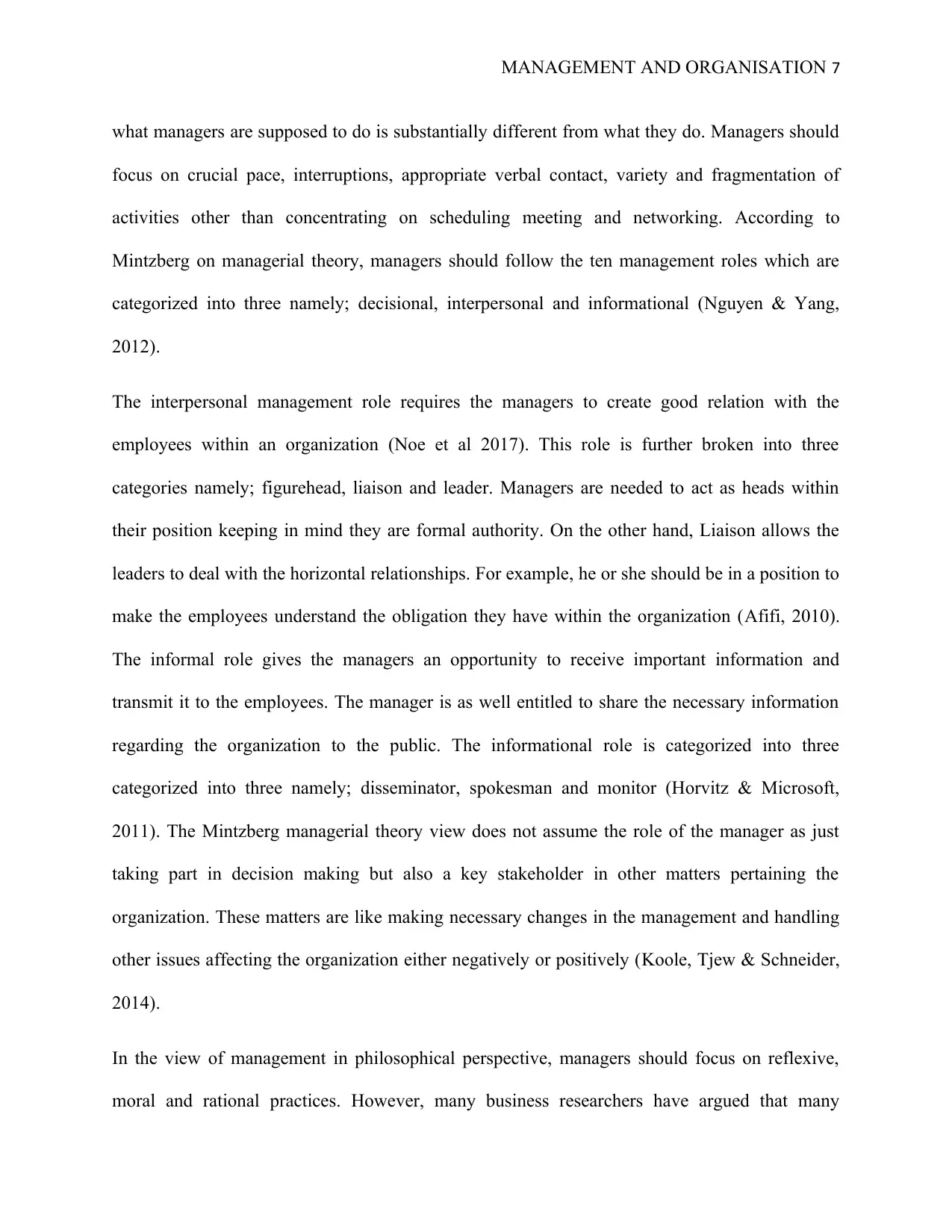
MANAGEMENT AND ORGANISATION 7
what managers are supposed to do is substantially different from what they do. Managers should
focus on crucial pace, interruptions, appropriate verbal contact, variety and fragmentation of
activities other than concentrating on scheduling meeting and networking. According to
Mintzberg on managerial theory, managers should follow the ten management roles which are
categorized into three namely; decisional, interpersonal and informational (Nguyen & Yang,
2012).
The interpersonal management role requires the managers to create good relation with the
employees within an organization (Noe et al 2017). This role is further broken into three
categories namely; figurehead, liaison and leader. Managers are needed to act as heads within
their position keeping in mind they are formal authority. On the other hand, Liaison allows the
leaders to deal with the horizontal relationships. For example, he or she should be in a position to
make the employees understand the obligation they have within the organization (Afifi, 2010).
The informal role gives the managers an opportunity to receive important information and
transmit it to the employees. The manager is as well entitled to share the necessary information
regarding the organization to the public. The informational role is categorized into three
categorized into three namely; disseminator, spokesman and monitor (Horvitz & Microsoft,
2011). The Mintzberg managerial theory view does not assume the role of the manager as just
taking part in decision making but also a key stakeholder in other matters pertaining the
organization. These matters are like making necessary changes in the management and handling
other issues affecting the organization either negatively or positively (Koole, Tjew & Schneider,
2014).
In the view of management in philosophical perspective, managers should focus on reflexive,
moral and rational practices. However, many business researchers have argued that many
what managers are supposed to do is substantially different from what they do. Managers should
focus on crucial pace, interruptions, appropriate verbal contact, variety and fragmentation of
activities other than concentrating on scheduling meeting and networking. According to
Mintzberg on managerial theory, managers should follow the ten management roles which are
categorized into three namely; decisional, interpersonal and informational (Nguyen & Yang,
2012).
The interpersonal management role requires the managers to create good relation with the
employees within an organization (Noe et al 2017). This role is further broken into three
categories namely; figurehead, liaison and leader. Managers are needed to act as heads within
their position keeping in mind they are formal authority. On the other hand, Liaison allows the
leaders to deal with the horizontal relationships. For example, he or she should be in a position to
make the employees understand the obligation they have within the organization (Afifi, 2010).
The informal role gives the managers an opportunity to receive important information and
transmit it to the employees. The manager is as well entitled to share the necessary information
regarding the organization to the public. The informational role is categorized into three
categorized into three namely; disseminator, spokesman and monitor (Horvitz & Microsoft,
2011). The Mintzberg managerial theory view does not assume the role of the manager as just
taking part in decision making but also a key stakeholder in other matters pertaining the
organization. These matters are like making necessary changes in the management and handling
other issues affecting the organization either negatively or positively (Koole, Tjew & Schneider,
2014).
In the view of management in philosophical perspective, managers should focus on reflexive,
moral and rational practices. However, many business researchers have argued that many
Paraphrase This Document
Need a fresh take? Get an instant paraphrase of this document with our AI Paraphraser
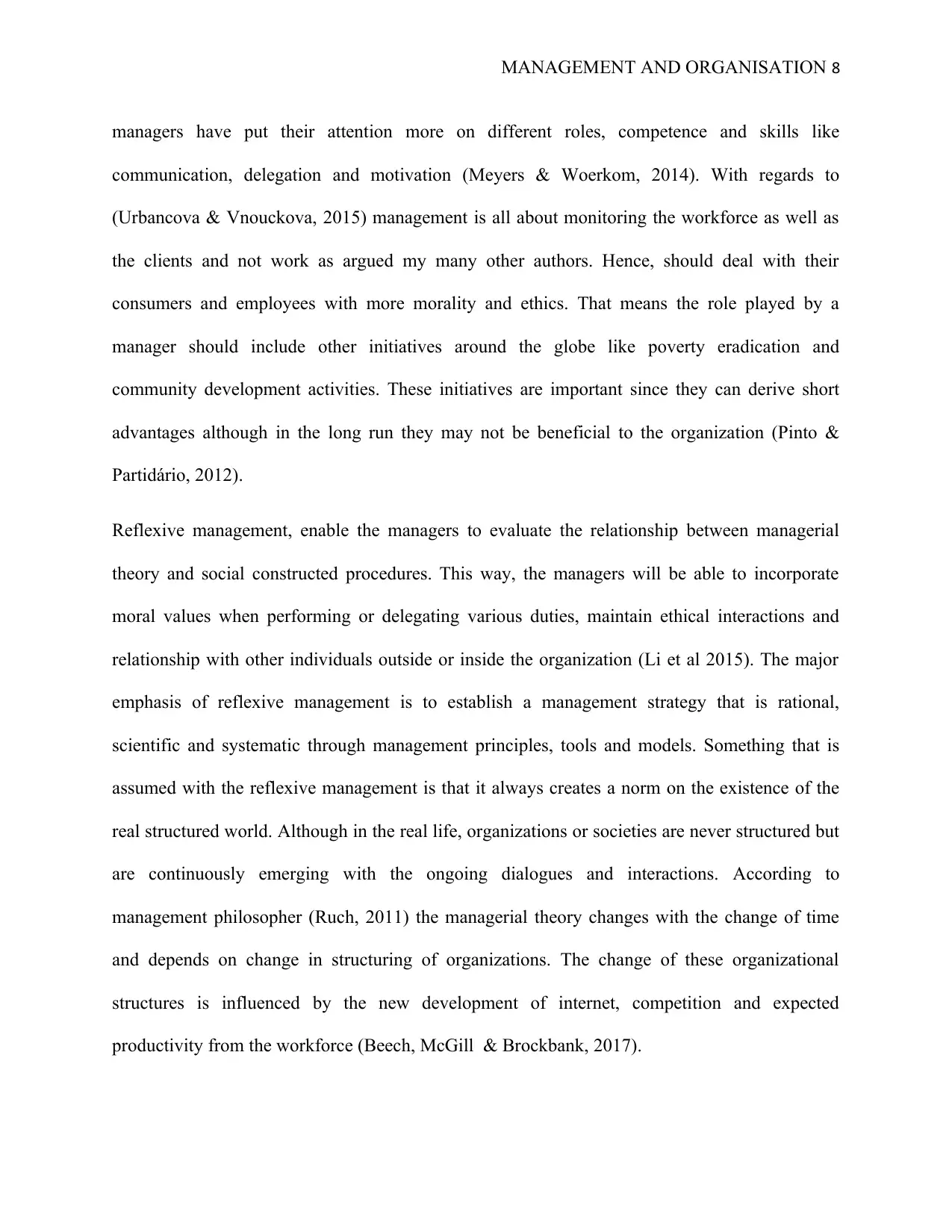
MANAGEMENT AND ORGANISATION 8
managers have put their attention more on different roles, competence and skills like
communication, delegation and motivation (Meyers & Woerkom, 2014). With regards to
(Urbancova & Vnouckova, 2015) management is all about monitoring the workforce as well as
the clients and not work as argued my many other authors. Hence, should deal with their
consumers and employees with more morality and ethics. That means the role played by a
manager should include other initiatives around the globe like poverty eradication and
community development activities. These initiatives are important since they can derive short
advantages although in the long run they may not be beneficial to the organization (Pinto &
Partidário, 2012).
Reflexive management, enable the managers to evaluate the relationship between managerial
theory and social constructed procedures. This way, the managers will be able to incorporate
moral values when performing or delegating various duties, maintain ethical interactions and
relationship with other individuals outside or inside the organization (Li et al 2015). The major
emphasis of reflexive management is to establish a management strategy that is rational,
scientific and systematic through management principles, tools and models. Something that is
assumed with the reflexive management is that it always creates a norm on the existence of the
real structured world. Although in the real life, organizations or societies are never structured but
are continuously emerging with the ongoing dialogues and interactions. According to
management philosopher (Ruch, 2011) the managerial theory changes with the change of time
and depends on change in structuring of organizations. The change of these organizational
structures is influenced by the new development of internet, competition and expected
productivity from the workforce (Beech, McGill & Brockbank, 2017).
managers have put their attention more on different roles, competence and skills like
communication, delegation and motivation (Meyers & Woerkom, 2014). With regards to
(Urbancova & Vnouckova, 2015) management is all about monitoring the workforce as well as
the clients and not work as argued my many other authors. Hence, should deal with their
consumers and employees with more morality and ethics. That means the role played by a
manager should include other initiatives around the globe like poverty eradication and
community development activities. These initiatives are important since they can derive short
advantages although in the long run they may not be beneficial to the organization (Pinto &
Partidário, 2012).
Reflexive management, enable the managers to evaluate the relationship between managerial
theory and social constructed procedures. This way, the managers will be able to incorporate
moral values when performing or delegating various duties, maintain ethical interactions and
relationship with other individuals outside or inside the organization (Li et al 2015). The major
emphasis of reflexive management is to establish a management strategy that is rational,
scientific and systematic through management principles, tools and models. Something that is
assumed with the reflexive management is that it always creates a norm on the existence of the
real structured world. Although in the real life, organizations or societies are never structured but
are continuously emerging with the ongoing dialogues and interactions. According to
management philosopher (Ruch, 2011) the managerial theory changes with the change of time
and depends on change in structuring of organizations. The change of these organizational
structures is influenced by the new development of internet, competition and expected
productivity from the workforce (Beech, McGill & Brockbank, 2017).
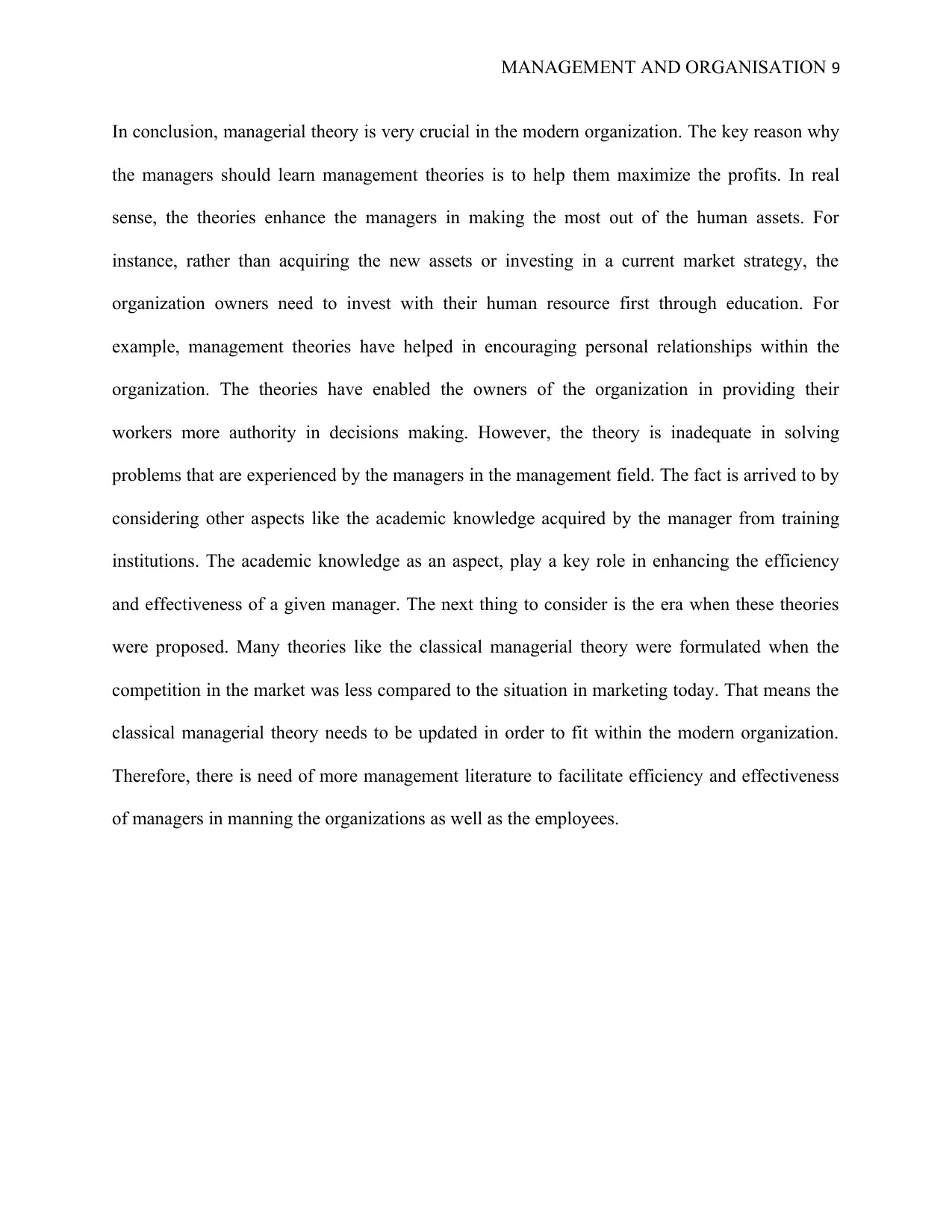
MANAGEMENT AND ORGANISATION 9
In conclusion, managerial theory is very crucial in the modern organization. The key reason why
the managers should learn management theories is to help them maximize the profits. In real
sense, the theories enhance the managers in making the most out of the human assets. For
instance, rather than acquiring the new assets or investing in a current market strategy, the
organization owners need to invest with their human resource first through education. For
example, management theories have helped in encouraging personal relationships within the
organization. The theories have enabled the owners of the organization in providing their
workers more authority in decisions making. However, the theory is inadequate in solving
problems that are experienced by the managers in the management field. The fact is arrived to by
considering other aspects like the academic knowledge acquired by the manager from training
institutions. The academic knowledge as an aspect, play a key role in enhancing the efficiency
and effectiveness of a given manager. The next thing to consider is the era when these theories
were proposed. Many theories like the classical managerial theory were formulated when the
competition in the market was less compared to the situation in marketing today. That means the
classical managerial theory needs to be updated in order to fit within the modern organization.
Therefore, there is need of more management literature to facilitate efficiency and effectiveness
of managers in manning the organizations as well as the employees.
In conclusion, managerial theory is very crucial in the modern organization. The key reason why
the managers should learn management theories is to help them maximize the profits. In real
sense, the theories enhance the managers in making the most out of the human assets. For
instance, rather than acquiring the new assets or investing in a current market strategy, the
organization owners need to invest with their human resource first through education. For
example, management theories have helped in encouraging personal relationships within the
organization. The theories have enabled the owners of the organization in providing their
workers more authority in decisions making. However, the theory is inadequate in solving
problems that are experienced by the managers in the management field. The fact is arrived to by
considering other aspects like the academic knowledge acquired by the manager from training
institutions. The academic knowledge as an aspect, play a key role in enhancing the efficiency
and effectiveness of a given manager. The next thing to consider is the era when these theories
were proposed. Many theories like the classical managerial theory were formulated when the
competition in the market was less compared to the situation in marketing today. That means the
classical managerial theory needs to be updated in order to fit within the modern organization.
Therefore, there is need of more management literature to facilitate efficiency and effectiveness
of managers in manning the organizations as well as the employees.
⊘ This is a preview!⊘
Do you want full access?
Subscribe today to unlock all pages.

Trusted by 1+ million students worldwide
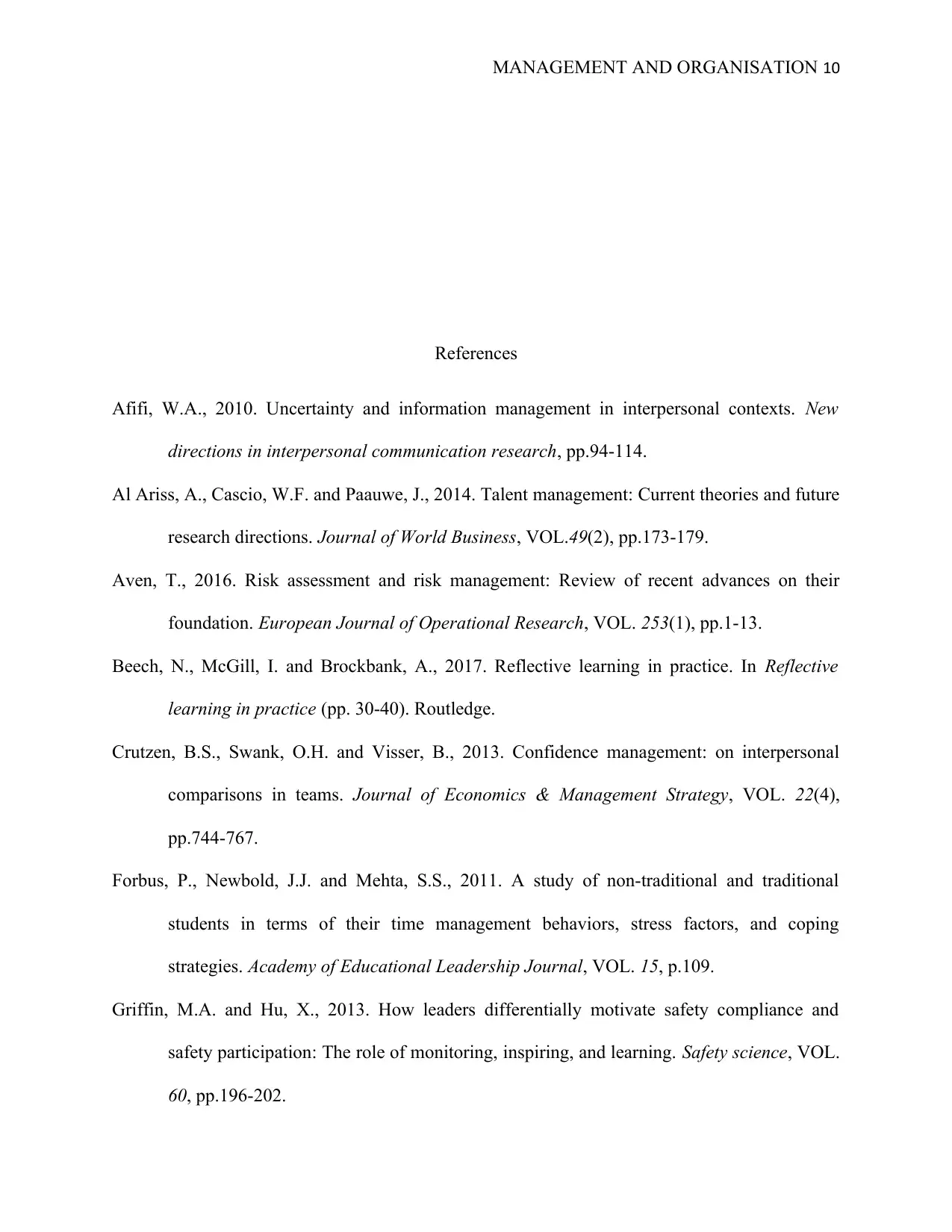
MANAGEMENT AND ORGANISATION 10
References
Afifi, W.A., 2010. Uncertainty and information management in interpersonal contexts. New
directions in interpersonal communication research, pp.94-114.
Al Ariss, A., Cascio, W.F. and Paauwe, J., 2014. Talent management: Current theories and future
research directions. Journal of World Business, VOL.49(2), pp.173-179.
Aven, T., 2016. Risk assessment and risk management: Review of recent advances on their
foundation. European Journal of Operational Research, VOL. 253(1), pp.1-13.
Beech, N., McGill, I. and Brockbank, A., 2017. Reflective learning in practice. In Reflective
learning in practice (pp. 30-40). Routledge.
Crutzen, B.S., Swank, O.H. and Visser, B., 2013. Confidence management: on interpersonal
comparisons in teams. Journal of Economics & Management Strategy, VOL. 22(4),
pp.744-767.
Forbus, P., Newbold, J.J. and Mehta, S.S., 2011. A study of non-traditional and traditional
students in terms of their time management behaviors, stress factors, and coping
strategies. Academy of Educational Leadership Journal, VOL. 15, p.109.
Griffin, M.A. and Hu, X., 2013. How leaders differentially motivate safety compliance and
safety participation: The role of monitoring, inspiring, and learning. Safety science, VOL.
60, pp.196-202.
References
Afifi, W.A., 2010. Uncertainty and information management in interpersonal contexts. New
directions in interpersonal communication research, pp.94-114.
Al Ariss, A., Cascio, W.F. and Paauwe, J., 2014. Talent management: Current theories and future
research directions. Journal of World Business, VOL.49(2), pp.173-179.
Aven, T., 2016. Risk assessment and risk management: Review of recent advances on their
foundation. European Journal of Operational Research, VOL. 253(1), pp.1-13.
Beech, N., McGill, I. and Brockbank, A., 2017. Reflective learning in practice. In Reflective
learning in practice (pp. 30-40). Routledge.
Crutzen, B.S., Swank, O.H. and Visser, B., 2013. Confidence management: on interpersonal
comparisons in teams. Journal of Economics & Management Strategy, VOL. 22(4),
pp.744-767.
Forbus, P., Newbold, J.J. and Mehta, S.S., 2011. A study of non-traditional and traditional
students in terms of their time management behaviors, stress factors, and coping
strategies. Academy of Educational Leadership Journal, VOL. 15, p.109.
Griffin, M.A. and Hu, X., 2013. How leaders differentially motivate safety compliance and
safety participation: The role of monitoring, inspiring, and learning. Safety science, VOL.
60, pp.196-202.
Paraphrase This Document
Need a fresh take? Get an instant paraphrase of this document with our AI Paraphraser
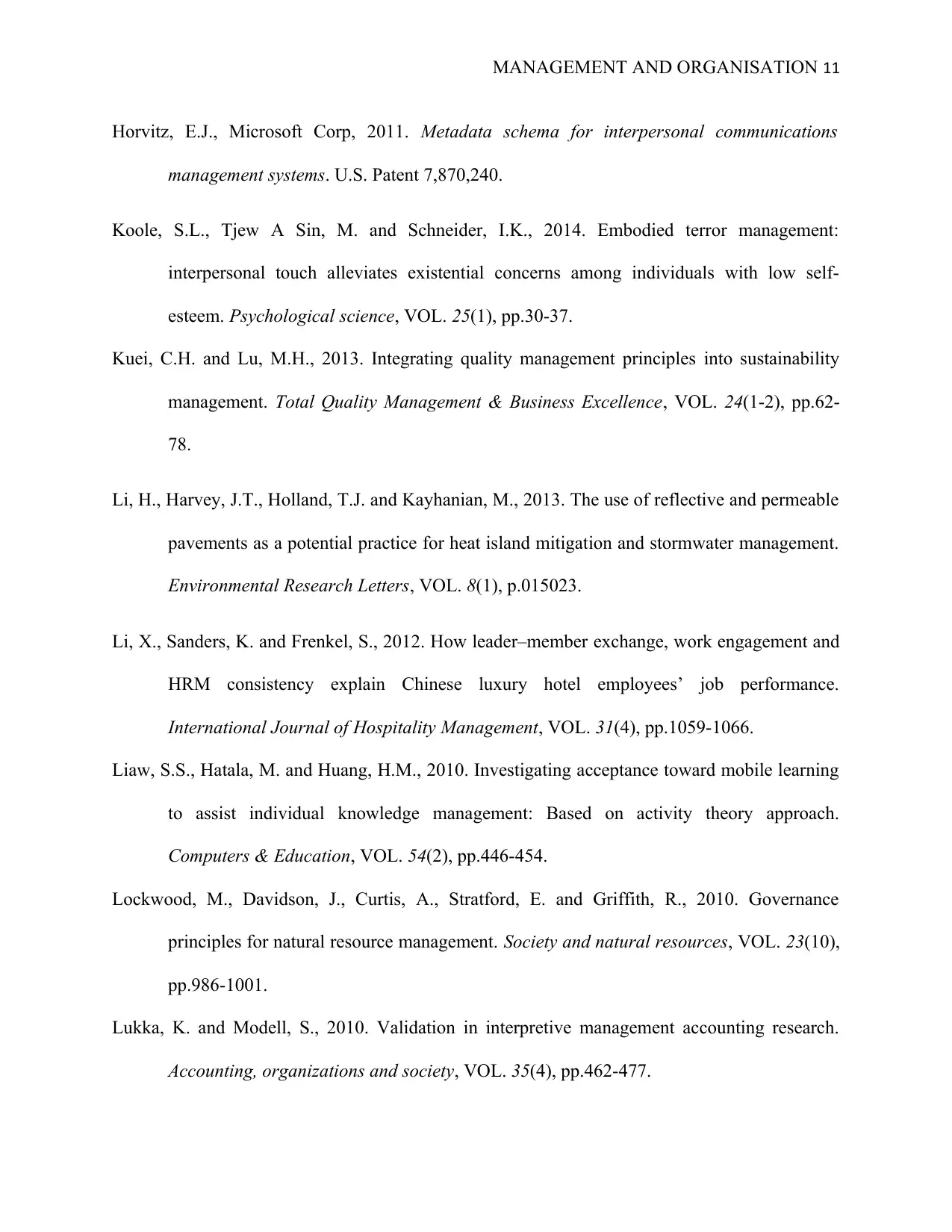
MANAGEMENT AND ORGANISATION 11
Horvitz, E.J., Microsoft Corp, 2011. Metadata schema for interpersonal communications
management systems. U.S. Patent 7,870,240.
Koole, S.L., Tjew A Sin, M. and Schneider, I.K., 2014. Embodied terror management:
interpersonal touch alleviates existential concerns among individuals with low self-
esteem. Psychological science, VOL. 25(1), pp.30-37.
Kuei, C.H. and Lu, M.H., 2013. Integrating quality management principles into sustainability
management. Total Quality Management & Business Excellence, VOL. 24(1-2), pp.62-
78.
Li, H., Harvey, J.T., Holland, T.J. and Kayhanian, M., 2013. The use of reflective and permeable
pavements as a potential practice for heat island mitigation and stormwater management.
Environmental Research Letters, VOL. 8(1), p.015023.
Li, X., Sanders, K. and Frenkel, S., 2012. How leader–member exchange, work engagement and
HRM consistency explain Chinese luxury hotel employees’ job performance.
International Journal of Hospitality Management, VOL. 31(4), pp.1059-1066.
Liaw, S.S., Hatala, M. and Huang, H.M., 2010. Investigating acceptance toward mobile learning
to assist individual knowledge management: Based on activity theory approach.
Computers & Education, VOL. 54(2), pp.446-454.
Lockwood, M., Davidson, J., Curtis, A., Stratford, E. and Griffith, R., 2010. Governance
principles for natural resource management. Society and natural resources, VOL. 23(10),
pp.986-1001.
Lukka, K. and Modell, S., 2010. Validation in interpretive management accounting research.
Accounting, organizations and society, VOL. 35(4), pp.462-477.
Horvitz, E.J., Microsoft Corp, 2011. Metadata schema for interpersonal communications
management systems. U.S. Patent 7,870,240.
Koole, S.L., Tjew A Sin, M. and Schneider, I.K., 2014. Embodied terror management:
interpersonal touch alleviates existential concerns among individuals with low self-
esteem. Psychological science, VOL. 25(1), pp.30-37.
Kuei, C.H. and Lu, M.H., 2013. Integrating quality management principles into sustainability
management. Total Quality Management & Business Excellence, VOL. 24(1-2), pp.62-
78.
Li, H., Harvey, J.T., Holland, T.J. and Kayhanian, M., 2013. The use of reflective and permeable
pavements as a potential practice for heat island mitigation and stormwater management.
Environmental Research Letters, VOL. 8(1), p.015023.
Li, X., Sanders, K. and Frenkel, S., 2012. How leader–member exchange, work engagement and
HRM consistency explain Chinese luxury hotel employees’ job performance.
International Journal of Hospitality Management, VOL. 31(4), pp.1059-1066.
Liaw, S.S., Hatala, M. and Huang, H.M., 2010. Investigating acceptance toward mobile learning
to assist individual knowledge management: Based on activity theory approach.
Computers & Education, VOL. 54(2), pp.446-454.
Lockwood, M., Davidson, J., Curtis, A., Stratford, E. and Griffith, R., 2010. Governance
principles for natural resource management. Society and natural resources, VOL. 23(10),
pp.986-1001.
Lukka, K. and Modell, S., 2010. Validation in interpretive management accounting research.
Accounting, organizations and society, VOL. 35(4), pp.462-477.
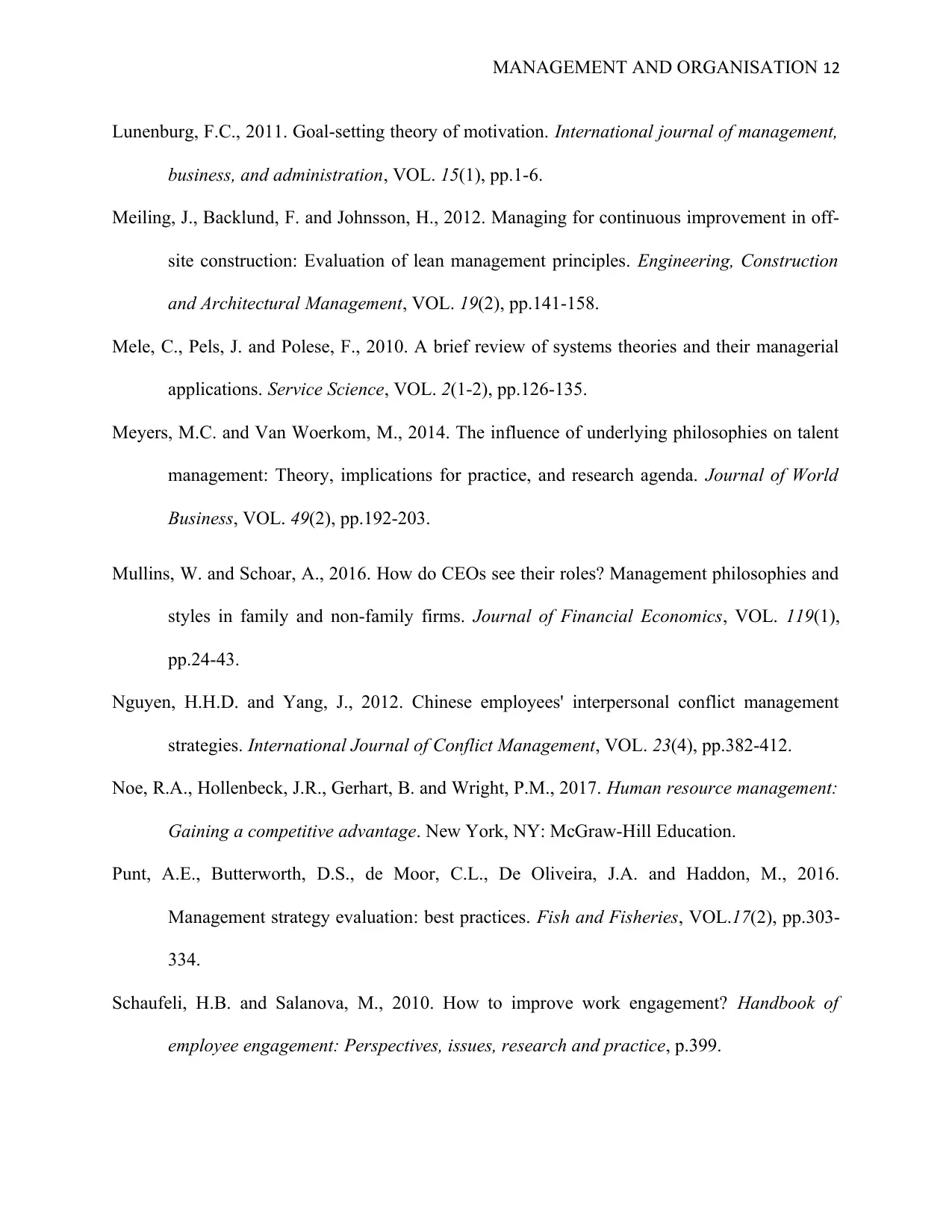
MANAGEMENT AND ORGANISATION 12
Lunenburg, F.C., 2011. Goal-setting theory of motivation. International journal of management,
business, and administration, VOL. 15(1), pp.1-6.
Meiling, J., Backlund, F. and Johnsson, H., 2012. Managing for continuous improvement in off-
site construction: Evaluation of lean management principles. Engineering, Construction
and Architectural Management, VOL. 19(2), pp.141-158.
Mele, C., Pels, J. and Polese, F., 2010. A brief review of systems theories and their managerial
applications. Service Science, VOL. 2(1-2), pp.126-135.
Meyers, M.C. and Van Woerkom, M., 2014. The influence of underlying philosophies on talent
management: Theory, implications for practice, and research agenda. Journal of World
Business, VOL. 49(2), pp.192-203.
Mullins, W. and Schoar, A., 2016. How do CEOs see their roles? Management philosophies and
styles in family and non-family firms. Journal of Financial Economics, VOL. 119(1),
pp.24-43.
Nguyen, H.H.D. and Yang, J., 2012. Chinese employees' interpersonal conflict management
strategies. International Journal of Conflict Management, VOL. 23(4), pp.382-412.
Noe, R.A., Hollenbeck, J.R., Gerhart, B. and Wright, P.M., 2017. Human resource management:
Gaining a competitive advantage. New York, NY: McGraw-Hill Education.
Punt, A.E., Butterworth, D.S., de Moor, C.L., De Oliveira, J.A. and Haddon, M., 2016.
Management strategy evaluation: best practices. Fish and Fisheries, VOL.17(2), pp.303-
334.
Schaufeli, H.B. and Salanova, M., 2010. How to improve work engagement? Handbook of
employee engagement: Perspectives, issues, research and practice, p.399.
Lunenburg, F.C., 2011. Goal-setting theory of motivation. International journal of management,
business, and administration, VOL. 15(1), pp.1-6.
Meiling, J., Backlund, F. and Johnsson, H., 2012. Managing for continuous improvement in off-
site construction: Evaluation of lean management principles. Engineering, Construction
and Architectural Management, VOL. 19(2), pp.141-158.
Mele, C., Pels, J. and Polese, F., 2010. A brief review of systems theories and their managerial
applications. Service Science, VOL. 2(1-2), pp.126-135.
Meyers, M.C. and Van Woerkom, M., 2014. The influence of underlying philosophies on talent
management: Theory, implications for practice, and research agenda. Journal of World
Business, VOL. 49(2), pp.192-203.
Mullins, W. and Schoar, A., 2016. How do CEOs see their roles? Management philosophies and
styles in family and non-family firms. Journal of Financial Economics, VOL. 119(1),
pp.24-43.
Nguyen, H.H.D. and Yang, J., 2012. Chinese employees' interpersonal conflict management
strategies. International Journal of Conflict Management, VOL. 23(4), pp.382-412.
Noe, R.A., Hollenbeck, J.R., Gerhart, B. and Wright, P.M., 2017. Human resource management:
Gaining a competitive advantage. New York, NY: McGraw-Hill Education.
Punt, A.E., Butterworth, D.S., de Moor, C.L., De Oliveira, J.A. and Haddon, M., 2016.
Management strategy evaluation: best practices. Fish and Fisheries, VOL.17(2), pp.303-
334.
Schaufeli, H.B. and Salanova, M., 2010. How to improve work engagement? Handbook of
employee engagement: Perspectives, issues, research and practice, p.399.
⊘ This is a preview!⊘
Do you want full access?
Subscribe today to unlock all pages.

Trusted by 1+ million students worldwide
1 out of 14
Related Documents
Your All-in-One AI-Powered Toolkit for Academic Success.
+13062052269
info@desklib.com
Available 24*7 on WhatsApp / Email
![[object Object]](/_next/static/media/star-bottom.7253800d.svg)
Unlock your academic potential
Copyright © 2020–2025 A2Z Services. All Rights Reserved. Developed and managed by ZUCOL.




